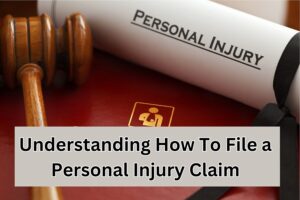How Does A Personal Injury Lawyer Etobicoke Value Pain And Suffering

To be injured by the actions of another person might be either an act of malice or simple carelessness. Broken bones, internal organ damage, or a chronic medical condition isn’t the only possible outcome of an accident.
When someone else’s carelessness results in your suffering, you’re entitled to compensation for your bodily and mental anguish with the help of a personal injury lawyer etobicoke. As the specifics of each accident and set of injuries differ, it’s difficult to provide a universal formula for determining how much compensation should be awarded for pain and suffering in personal injury cases.
The Economic Value Of Pain And Suffering
Payments for pain and suffering in personal injury cases are meant to compensate victims for the anguish they’d have avoided had the accident not happened. Courts often look at the information offered in a personal injury lawsuit and assess what’s fair and just in light of the victim’s circumstances, even if there’s no clear and particular measurement or standard by which pain and suffering damages are determined intrinsically.
Pain and suffering extend far beyond actual physical injuries; an example is the case of a parent who can never pick up their child again or a person who’s permanently and utterly incapacitated as a result of an accident. Traumatic brain injury is one type of medical problem that may have long-lasting and irreversible effects. The negligent party should pay for these losses regardless of whether they can be quantified in dollars.
How To Calculate Compensation For Pain And Suffering
Insurance companies, personal injury lawyers, courts, and juries look at a wide range of variables as a means of calculating compensation to be paid out for emotional distress. They frequently consider the following:
- The negligence with which the defendant behaved
- The general emotional and physiological distress that the typical victim of such injuries experiences
- How your injuries will change your life
- How it affects your job
- How you feel, and how long it’ll take for the injury to heal
- What specific medical care has the victim already received and will need in the future
- The injury’s long-term outlook
A single formula can’t determine damages for emotional distress in a personal injury case; each case is different.
Who Can Best Back Up Your Claims?
Regardless of where your negotiations end up, having the testimony of outside parties always helps. Your best choice would be medical professionals who have responded to or worked on your personal injuries. The law always favors solid evidence, which these people can easily provide you with in most circumstances. An excellent personal injury lawyer would reach out to those who have worked on your case to increase the legitimacy of your pain and suffering claims.
Here are some you can work with in your personal injury case:
- Neurologist: A neurologist specializes in diagnosing and treating conditions related to the nervous system. They can provide expert opinions on neurological injuries, such as traumatic brain injuries (TBI), nerve damage, or spinal cord injuries, significantly contributing to pain and suffering claims.
- Psychiatrists or psychologists: They evaluate and diagnose psychological and emotional trauma resulting from the injury. They can provide expert testimony on conditions such as post-traumatic stress disorder (PTSD), anxiety, depression, and other emotional distress related to the incident.
- Pain management specialists: These professionals are trained in managing chronic pain conditions and can assess and document the extent of pain experienced by the injured party.
- Rehabilitation specialists: They can document the progress and limitations in the injured person’s rehabilitation journey, showing the extent of their recovery efforts and any remaining deficits.
- Primary care physicians: This professional can provide a comprehensive overview of your medical history, initial diagnosis, treatment plans, and specialist referrals. They can also testify to your overall health before and after the accident.
Methods To Calculate Compensation For Pain And Suffering
As there’s no way to measure it, the injured person’s pain and suffering are estimated by how bad and how long their physical and mental anguish was after the accident. It can be difficult to put a precise price on pain and suffering, but your personal injury lawyer can help you make educated estimates using the following methods:
- Multiplier Method
With the multiplier method, the cost of a personal injury lawsuit is multiplied by a number between 1.5 and 5. If the actual damages in a personal injury case, like medical bills and lost wages, are $10,000, and the judge or jury uses a multiplier of 2, the non-economic damages, like pain and suffering, add up to $20,000. The type and extent of an accident and injuries usually dictate whether the pain and suffering multiplier method is applied and what the actual multiplier number should be.
- Per Diem Method
From the time of the incident until the victim reaches ‘maximum medical improvement,’ the pain and suffering per diem method calculates a dollar amount for each day the victim was injured. The date of maximum medical improvement is set when the victim has fully recovered or when a doctor says the injury makes it impossible for the victim’s health to improve.
These are the methods that make compensation for pain and suffering quantifiable.
How to Prove Financial Losses Due to Suffering
Pain and suffering can be either mental or physical, but evidence will be needed. Examples of such supporting paperwork could be:
- Expert medical or mental health witness reports and evidence in writing or on the stand
- Notes from a mental health practitioner, such as a therapist or psychiatrist
- Your own written record of all suffering (journals, notes, and diaries)
- Photographs
- Verified Medical Indications
- Personal Testimony
- Declarations from close associates
Your ability to document the extent of your suffering will be used by all parties, like the insurance company, judge, and jury, to determine compensation.
The Wrap-Up
In most personal injury settlement negotiations, the amount of compensation paid for the plaintiff’s pain and suffering is a major source of controversy. Negligence victims’ attempts at settlement negotiation often fall through due to opposing views on how much their suffering was worth beyond monetary compensation.
Damages for mental anguish are a common component of negligence settlements, and they require the expertise of lawyers with experience in this area. They have an in-depth understanding of the law and can effectively use it to pursue maximum compensation on their client’s behalf.
If you’ve been hurt and are wondering if you can get money for your pain, suffering, and other losses, seek the advice of an experienced personal injury lawyer.






